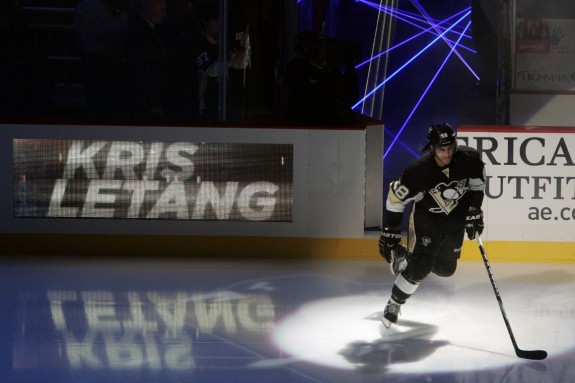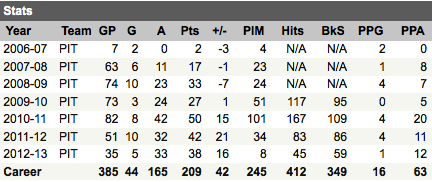
Not every General Manager looks forward to a blank canvas.
The Pittsburgh Penguins only have six players signed beyond next season. For some teams, that’s a sure sign of a rebuild.
The list of quality players available in free agency seems to shrink every summer and it’s driven market values through the roof. At 39, Sergei Gonchar is only worth $5 million a year when a team needs a player like Gonchar and there’s no one else available. The Dallas Stars won’t be competing for a Stanley Cup next year though. Champions aren’t built through free agency in today’s NHL.
But the Pittsburgh Penguins don’t pay market price for most of their players. They’ve become a destination franchise and can convince players to accept less than their true value in exchange for world-class facilities and the opportunity to compete for a Stanley Cup.
It starts with Sidney Crosby and Evgeni Malkin.
Both players could have commanded league-maximum salaries, but instead accepted team-friendly contract extensions. Their example has trickled down throughout the lineup and everyone from top line wingers to backup goaltenders have been willing to take a pay cut with the Penguins as well.
Now that Crosby and Malkin will be together with the Penguins for at least the next nine seasons, General Manager Ray Shero has to decide how to build around the high-priced superstars.
Most importantly, he has to decide what to do with Norris Trophy candidate defenseman Kris Letang.
____________________________
Who is Kris Letang?

Letang has one year remaining on his contract with the Penguins and could receive contract offers that no other NHL defenseman has received since the salary cap was instituted in 2005.
Over the past three seasons, only one defenseman — Erik Karlsson (0.79) — has a higher point-per-game average than Letang (0.77). He skates like the wind and has deceptive lower-body strength for a player who is only six feet tall.
He plays against top competition on a nightly basis and led the Penguins in ice time per game this season, including almost seven minutes per night on special teams.
Letang deserved nomination for the Norris Trophy last season but missed 31 games to injury. He made it onto the ballot this year after scoring at a ridiculous 89-point full season pace. For perspective, consider that no defenseman has scored 90 or more points in a season since Ray Bourque in 1994.
But Letang didn’t do much to boost his stock in the 2013 playoffs.
Sure, the points were still there (he still leads all defensemen with 16), but Letang is also a big reason the Penguins are sitting at home this week while the Boston Bruins play for the Stanley Cup.
Letang was on the ice for 7 of the 12 goals the Bruins scored in the Eastern Conference Finals and was directly responsible for a number of them:
The give and take with Letang is what makes him such an enigma.
He played poorly against Ottawa in Game 3 of the second round, but finished the night with four assists and the Penguins won 7-3. As the Penguins and other teams evaluate Letang at age 26 and project his potential value and upside, there are a lot of unknowns.
With the right coaching and guidance, Letang could tighten up the defensive aspects of his game and become one of the most dominating players in the league.
On the other hand, he hasn’t exhibited the same decision-making abilities that an undersized player like Scott Niedermayer did. Niedermayer was a great skater that was able to play at a high level well into his 30’s because he had elite hockey sense. When Letang’s skating starts to decline with age, will he still be able to provide big-time value on a big-time deal?
And how much of Letang’s production is a result of playing with Crosby and Malkin?
Over the past three seasons, Crosby and Letang have been in and out of the lineup quite a bit with injuries. Letang has 64 points in 66 games (0.93 per game) when Crosby is in the lineup and just 66 in 99 games when Crosby is out (0.67). Would Letang be able to produce with minimal help on another team that decides to build around him as the franchise player?
There’s still no doubt that GM’s around the league would be lined up to take those risks if Letang ever reaches the free agent market.
Just playing for a high-profile team like Pittsburgh gets him exposure that other players of his caliber never experience. Oliver Ekman-Larsson is every bit as good as Kris Letang, but very few hockey fans know anything about Ekman-Larrson because he plays a more conservative style and gets no attention with the Phoenix Coyotes.
Additionally, point-producing defensemen get Norris Trophy nominations (this year’s nominees were 1, 2, 3 in scoring) and Norris Trophy nominations lead to big paydays.
Norris-worthy defensemen Ryan Suter and Shea Weber both cashed in last summer on monster contract extensions. Weber’s front-loaded deal is paying him $14 million a season right now and carries a $7.86m cap hit over 14 years.

Suter’s career path is almost identical to Letang’s. Both players moved from entry-level rookie deals to four-year bridge contracts at a $3.5m cap hit. Suter — two years older than Letang — hit the open market last summer and cashed in on a 13-year deal with Minnesota worth $98 million ($7.5m cap hit).
The new collective bargaining agreement put an end to heavy front-loaded deals though. Players are only allowed to sign eight year extensions with their current teams and seven year contracts on the open market. Additionally, annual salary in a long term deal may only vary by 35% of the first year’s salary, and the lowest year salary cannot be less than 50% of the highest year.
In english?
No more salary cap games. If you want a top player like Letang when he hits unrestricted free agency, you’re going to have to pay him big money in his prime and absorb the high cap hit.
When Letang was asked the other day what kind of money he’d be looking for in his contract extension, he said, “there is no number.”
He wasn’t being a jerk. He’s right. There’s no precedent for the type of deal he’s looking to get. Over the next few years, player contracts will reach shocking levels as the salary cap rises and the front-loaded cap games disappear. Six players in the NHL will make $10 million or more next season, but imagining a player with a $10 million cap hit seems outrageous.
Let’s dig deeper into the Suter contract to come up with a starting point for estimating Letang’s open market value.
If you add up the salary Suter will be paid in the first eight years of his deal, it will effectively pay him $10 million per season. Of course, it was front-loaded and the only way Minnesota could absorb the contract was because of the lower cap hit, but $8 million annually as a starting point for Letang isn’t crazy by any means.
Because of the points-per-game stat, many have argued Erik Karlsson and his $6.5 million long-term cap hit is a good comparison, but he and Letang aren’t dealing with comparable contracts. Karlsson’s deal was his second contract in the league and includes a mix of restricted and unrestricted free agent years.
What does this mean?
Very few teams follow through with offer sheets for RFA’s meaning RFA salary is more or less dictated by the team that owns the player. Leverage changes hands when a player hits unrestricted free agency. For that reason, “buying” a player’s UFA years and the freedom that comes with them has to come at a premium to RFA years. Karlsson’s deal includes four RFA years and three UFA years. That’s very different than seven or eight UFA years for Letang.
Ryan Getzlaf and Corey Perry — two very good but not superstar players — have received two of the biggest UFA-stage contracts signed so far under the new CBA. Getzlaf’s cap hit is $8.3m and Perry is at $8.6m. The Dallas Stars paid Sergei Gonchar $5 million a season despite the fact his career is on the steep decline.
Want to make an argument Letang could get $9 million? Maybe more?
You’re not out of line.
Winning games is one thing, but highlight reel moves like this from Letang would sell a lot more tickets than Ryan Suter would:
____________________________
The Penguins Perspective
Can the Penguins afford to pay Letang $9 million per season over the long term?
Absolutely. Shero and cap specialist Jason Botterill have the flexibility to do anything they want as they build their franchise for the long term.
Next season, the cap hits for Crosby, Malkin, and Letang will make up 32% of the Penguins payroll under the lower $64.3 million salary cap. The cap can never fall below $64.3m in the new agreement and is driven by the business success of the NHL.
Commissioner Gary Bettman said last week that he expects next year’s league revenues to easily return to the $3.3 billion level that they were in 2011-12. I don’t doubt him one bit. The league will add a number of extra outdoor games that should create buzz — at least for the first year — and league revenues could explode from there.
The NHL has guaranteed revenue from a long-term television contract with NBC and has set the table for likely expansion in the next few years. If struggling franchises like Phoenix and New Jersey can get on solid financial footing and Bettman can add new teams in Quebec and Toronto, the salary cap could start to rise very quickly.
Even at a conservative five percent growth estimate, which was fairly standard for the league under the prior CBA, the salary cap would be in the $85 to $90 million range by the time Letang’s eight-year contract extension would expire.
Let’s assume Letang gets $9 million and the salary cap rises to $85 million by 2021-22. The Penguins would have the same 32% of their payroll committed to Crosby, Malkin, and Letang.
So we know the Penguins can do it.
But should they do it? Not exactly.
In Part 2 we take a look at that issue and project how the negotiations might unfold over the coming days and weeks.
[Click here to read Part 2]
____________________________
You made some good points, especially on how enigmatic he is. I don’t think the Perry, Getzlaf, and Gonchar deals are appropriate comparisons, though, because all of them are overpaid, especially Gonchar. Shero–and probably the Penguins as an organization–will never offer an albatross contract apart from Crosby and Malkin, who are not even just franchise players but once-a-generation talents.
Letang is not even a franchise player, which I would argue Getzlaf is. I would also argue that Letang is not an elite defenseman but more like the best fourth forward in the league, which is the opposite of what the Penguins need. Thus, if the Penguins want to keep him, I can’t see the cap hit starting with anything but a six. Seven would be too much; less than six would probably make Letang and his agent laugh.
He very well could command an out-of-line cap hit, which I would consider anything more than $7.25 million. But if a player is that expensive and in demand, why would you not trade him for the bounty you’d get in return, especially considering his flaws?
I hope to read about your thoughts on possible trade partners in Part Two.